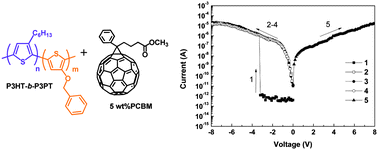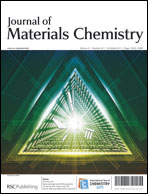Electrically bistable memory devices based on all-conjugated block copolythiophenes and their PCBM composite films†
Abstract
We explore the memory device characteristics of the all-conjugated diblock copolythiophenes, poly(3-hexylthiophene)-block-poly(3-phenoxymethylthiophene) (P3HT-b-P3PT), and their blends with PCBM. The field-effect transistors prepared from P3HT-b-P3PT showed a significant hysteresis between the forward and backward gate-bias scans in the transfer curve, indicating the occurrence of charge trapping. The charge trapping may have occurred within the amorphous P3PT domains dispersed in the block copolythiophene by preventing charge transport. P3HT525252-bbb-P3PT393939 and P3HT102102-bb-P3PT3737 exhibited dynamic random access memory (DRAM) behavior in the sandwich configuration of ITO/P3HT-b-P3PT/Al, whereas P3HT only showed semiconductor characteristics, suggesting the significant effect of the amorphous P3PT segments on the electrical switching behavior. By blending a small amount (5–10 wt%) of PCBM into P3HT-b-P3PT of different block ratios (P3HT525252-bbb-P3PT393939, P3HT102102-bb-P3PT3737, and P3HT8989-bb-P3PT2323), the memory devices showed a write-once-read-many times (WORM) behavior with the switching voltages of −2.6 to −3.3 V and high ON/OFF ratios (105 to 107). The mechanism associated with the memory characteristics was the charge transfer from the P3HT-b-P3PT donor to the PCBM acceptor, which stabilized the charge separated state and retained the high conductance state for a long time during the ON stage. These experimental results provide a new strategy of designing all-conjugated


 Please wait while we load your content...
Please wait while we load your content...